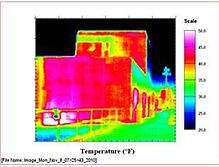So you want to have an energy audit on your building. You have carefully screened your provider (see our document on questions to ask), and you have management buy-in to have an audit done. You also collected all the information the auditor requested. (Note: if the auditor does not ask you for any information in advance, for example, a minimum of three years of utility records, you are not likely to receive a thorough analysis.)
Here are the top 5 areas your energy audit should address:
#5 Plug Load: The plug load is relatively easy to minimize. “Plug” load is exactly what it says, i.e., all the electricity-using devices that are plugged into the wall or floor receptacles. These chargers may use more power while simply plugged in doing nothing than when they’re attached to laptop computers, mobile phones, iPads, etc. How? Because the charger uses a small amount of energy all the time it’s plugged in. Likewise, larger equipment such as printers or copiers, if not properly programmed or not Energy Star-rated, can use more power sitting idle than when they’re actually being used.
Recommendations often include:
- Set computers, printers, copiers, etc. to “sleep” when not in use.
- Do not leave chargers plugged into the outlet when the device they serve is not being charged. A simple and inexpensive method is to have a remote strip on a desk with the devices plugged into it. When the devices are not being charged, or when people leave the office, they can simply turn off the power strip. Some power strips can be set to turn off automatically after a specific period of non-use.
#4 Lighting: Lighting is one area where you can literally see a big difference. Most everyone knows you should be using compact fluorescent bulbs in lamps. If you still use T12s in your overhead lighting, you should switch to T8s or even lower, if they will sufficiently illuminate the area. More and more, light fixtures, especially in larger commercial buildings and parking areas, use brighter, lower-wattage LED bulbs. Consider replacing standard bulbs with LED bulbs if they fit your existing fixtures. If you have windows, use them properly – keep shades open during the day, but be careful of glare from sunlight. Daylight not only saves energy but also can improve people’s productivity.
#3 Water: Unless you are doing major bathroom renovations it may not be practical to replace all the toilets or urinals. But here are some no-cost/low-cost things you can do:
- Install inexpensive aerators on all the faucets.
- Check all the faucets, under all the sinks and around all the toilets for signs of leaks. Fix any you find. A single leaky faucet can waste over 1,000 gallons of water a year. Calculate your potential loss here http://ga.water.usgs.gov/edu/sc4.html.
- If your office has a dishwasher, make sure it runs only when full. Ask staff to hand-wash coffee cups if there are too few in the dishwasher to make a full load.
- Change the flush valves on the urinals to handle less water, but be careful in older buildings not to go too low.
Note: Many auditors skip water. They don’t consider it energy. But it takes energy to heat and move the water through the building. Water is a utility cost and you pay for how much you use. So using less is better! But you won’t know how to do it most effectively unless your auditor points out the opportunities.
#2 Building Envelope: The best way to test the building envelope it is with infrared thermography and a blower door test - where feasible. Here’s how they work and what you may find.

The auditor uses an infrared camera to take a standard photo of a particular area of a building, e.g., wall, roof, etc. The auditor then uses infrared rays to take an infrared photo of the same area. The infrared rays, without using any destructive testing methods, show you where your building is conducting heat either inward or outward.
A blower door test helps find the areas that are leaking air into the building. The blower door creates a negative pressure in the building while the auditor moves about the building looking for drafts. This helps pinpoint the leak, which can then be remediated.
#1 HVAC and Controls: In a typical building, heating and cooling are the areas that use the most energy. It makes sense that you will get the biggest bang for your buck here.
We often find enormous waste in air handling system economizers. They are either not set for the proper amount of outside air, not closed during unoccupied hours, leaking air when closed, or not working at all because of linkage failure or control problems.
Your building energy auditor should also examine all programmable thermostats to ensure they are calibrated and set for the proper times and temperature. This will help minimize the amount of energy used to heat or cool the spaces. We continually find programmable thermostats that have never been set up properly.
If your energy audit report does not thoroughly address these five areas, you will never benefit from the full amount of cost and energy savings possible – and potential improvement in indoor air quality (IAQ) and employee or tenant satisfaction.



